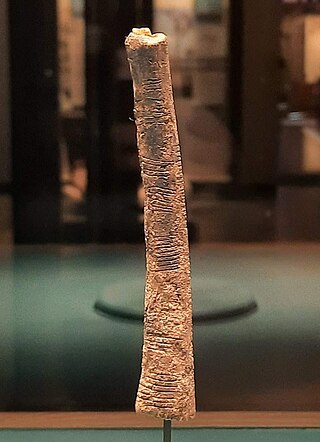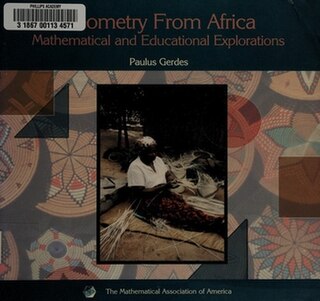Related Research Articles

The decimal numeral system is the standard system for denoting integer and non-integer numbers. It is the extension to non-integer numbers of the Hindu–Arabic numeral system. The way of denoting numbers in the decimal system is often referred to as decimal notation.
In linguistics, a numeral in the broadest sense is a word or phrase that describes a numerical quantity. Some theories of grammar use the word "numeral" to refer to cardinal numbers that act as a determiner that specify the quantity of a noun, for example the "two" in "two hats". Some theories of grammar do not include determiners as a part of speech and consider "two" in this example to be an adjective. Some theories consider "numeral" to be a synonym for "number" and assign all numbers to a part of speech called "numerals". Numerals in the broad sense can also be analyzed as a noun, as a pronoun, or for a small number of words as an adverb.
A senary numeral system has six as its base. It has been adopted independently by a small number of cultures. Like decimal, it is a semiprime, though it is unique as the product of the only two consecutive numbers that are both prime. As six is a superior highly composite number, many of the arguments made in favor of the duodecimal system also apply to senary.

Babylonian cuneiform numerals, also used in Assyria and Chaldea, were written in cuneiform, using a wedge-tipped reed stylus to print a mark on a soft clay tablet which would be exposed in the sun to harden to create a permanent record.
Counting is the process of determining the number of elements of a finite set of objects; that is, determining the size of a set. The traditional way of counting consists of continually increasing a counter by a unit for every element of the set, in some order, while marking those elements to avoid visiting the same element more than once, until no unmarked elements are left; if the counter was set to one after the first object, the value after visiting the final object gives the desired number of elements. The related term enumeration refers to uniquely identifying the elements of a finite (combinatorial) set or infinite set by assigning a number to each element.
A numerical digit or numeral is a single symbol used alone or in combinations, to represent numbers in a positional numeral system. The name "digit" comes from the fact that the ten digits of the hands correspond to the ten symbols of the common base 10 numeral system, i.e. the decimal digits.
Ancient Egyptian mathematics is the mathematics that was developed and used in Ancient Egypt c. 3000 to c. 300 BCE, from the Old Kingdom of Egypt until roughly the beginning of Hellenistic Egypt. The ancient Egyptians utilized a numeral system for counting and solving written mathematical problems, often involving multiplication and fractions. Evidence for Egyptian mathematics is limited to a scarce amount of surviving sources written on papyrus. From these texts it is known that ancient Egyptians understood concepts of geometry, such as determining the surface area and volume of three-dimensional shapes useful for architectural engineering, and algebra, such as the false position method and quadratic equations.
The anti-bias curriculum is a curriculum which attempts to challenge prejudices such as racism, sexism, ableism, ageism, weightism, homophobia, classism, colorism, heightism, handism, religious discrimination and other forms of kyriarchy. The approach is favoured by civil rights organisations such as the Anti-Defamation League.
Culturally relevant teaching or responsive teaching is a pedagogy grounded in teachers' practice of cultural competence, or skill at teaching in a cross-cultural or multicultural setting. Teachers using this method encourage each student to relate course content to their cultural context.
Ethnocomputing is the study of the interactions between computing and culture. It is carried out through theoretical analysis, empirical investigation, and design implementation. It includes research on the impact of computing on society, as well as the reverse: how cultural, historical, personal, and societal origins and surroundings cause and affect the innovation, development, diffusion, maintenance, and appropriation of computational artifacts or ideas. From the ethnocomputing perspective, no computational technology is culturally "neutral," and no cultural practice is a computational void. Instead of considering culture to be a hindrance for software engineering, culture should be seen as a resource for innovation and design.
Claudia Zaslavsky was an American mathematics teacher and ethnomathematician.
Yuki, also known as Ukomno'm, is an extinct language of California, formerly spoken by the Yuki people. The Yuki are the original inhabitants of the Eel River area and the Round Valley Reservation of northern California. Yuki ceased to be used as an everyday language in the early 20th century and its last speaker, Arthur Anderson, died in 1983. Yuki is generally thought to be distantly related to the Wappo language.

The Ishango bone, discovered at the "Fisherman Settlement" of Ishango in the Democratic Republic of the Congo, is a bone tool and possible mathematical device that dates to the Upper Paleolithic era. The curved bone is dark brown in color, about 10 centimeters in length, and features a sharp piece of quartz affixed to one end, perhaps for engraving. Because the bone has been narrowed, scraped, polished, and engraved to a certain extent, it is no longer possible to determine what animal the bone belonged to, although it is assumed to have been a mammal.
Number systems have progressed from the use of fingers and tally marks, perhaps more than 40,000 years ago, to the use of sets of glyphs able to represent any conceivable number efficiently. The earliest known unambiguous notations for numbers emerged in Mesopotamia about 5000 or 6000 years ago.

The Pame languages are a group of languages in Mexico that is spoken by around 12,000 Pame people in the state of San Luis Potosí. It belongs to the Oto-Pamean branch of the Oto-Manguean language family.

Finger-counting, also known as dactylonomy, is the act of counting using one's fingers. There are multiple different systems used across time and between cultures, though many of these have seen a decline in use because of the spread of Arabic numerals.

Ron Eglash is an American who works in cybernetics, professor in the School of Information at the University of Michigan with a secondary appointment in the School of Design, and an author widely known for his work in the field of ethnomathematics, which aims to study the diverse relationships between mathematics and culture.
Modern elementary mathematics is the theory and practice of teaching elementary mathematics according to contemporary research and thinking about learning. This can include pedagogical ideas, mathematics education research frameworks, and curricular material.
Critical mathematics pedagogy is an approach to mathematics education that includes a practical and philosophical commitment to liberation. Approaches that involve critical mathematics pedagogy give special attention to the social, political, cultural and economic contexts of oppression, as they can be understood through mathematics. They also analyze the role that mathematics plays in producing and maintaining potentially oppressive social, political, cultural or economic structures. Finally, critical mathematics pedagogy demands that critique is connected to action promoting more just and equitable social, political or economic reform.

Geometry From Africa: Mathematical and Educational Explorations is a book in ethnomathematics by Paulus Gerdes. It analyzes the mathematics behind geometric designs and patterns from multiple African cultures, and suggests ways of connecting this analysis with the mathematics curriculum. It was published in 1999 by the Mathematical Association of America, in their Classroom Resource Materials book series.
References
- ↑ (D'Ambrosio, 1999, 146) D'Ambrosio. (1999). Literacy, Matheracy, and Technoracy: A Trivium for Today. Mathematical Thinking and Learning 1(2), 131-153.
- ↑ (D'Ambrosio, 1997, may paraphrases Ascher 1986)
- ↑ (Powell and Frankenstein, 1997 quoting D'Ambrosio) Powell, Arthur B., and Marilyn Frankenstein (eds.) (1997). Ethnomathematics: Challenging Eurocentrism in Mathematics Education, p.7. Albany, NY: State University of New York Press. ISBN 0-7914-3351-X
- ↑ (D'Ambrosio 1997) D'Ambrosio. (1997). "Foreword", Ethnomathematics, p.xv and xx. ISBN 0-7914-3352-8.
- ↑ (D'Ambrosio, 1985) D'Ambrosio. (1985). Ethnomathematics and its place in the history and pedagogy of mathematics. For the Learning of Mathematics, 5, 44-8.
- ↑ (Gerdes, 1986)
- ↑ (Ascher, 1986)
- ↑ (D.Ambrosio, 1987)
- ↑ (Bishop, 1988)
- ↑ (Ascher, 1991) Ascher, Marcia (1991). Ethnomathematics: A Multicultural View of Mathematical Ideas. Pacific Grove, Calif.: Brooks/Cole. ISBN 0-412-98941-7
- ↑ (Pompeu, 1994)
- ↑ (Presmeg, 1996)
- ↑ (Knijnik, 1998)
- ↑ (D'Ambrosio, 1999, 146)
- ↑ (Eglash et al. 2006) Eglash, R., Bennett, A., O'Donnell, C., Jennings, S., and Cintorino, M. "Culturally Situated Design Tools: Ethnocomputing from Field Site to Classroom." American Anthropologist, Vol. 108, No. 2. (2006), pp. 347–362.
- ↑ (See Menninger (1934, 1969).) Menninger, Karl (1934), Zahlwort und Ziffer. Revised edition (1958). Göttingen: Vandenhoeck and Ruprecht. (See Menninger (1934, 1969).) Menninger, Karl (1969), Number Words and Number Symbols. Cambridge, Massachusetts: The MIT Press.
- ↑ Zaslavsky (1973) Zaslavsky, Claudia (1973). Africa Counts: Number and Pattern in African Culture. Third revised ed., 1999. Chicago: Lawrence Hill Books. ISBN 1-55652-350-5
- ↑ "Bien écrire et parler juste, guide pratique d'expression et de communication". Sélection du Reader's Digest (in French). p. 21.
- ↑ Cormier, Yves (2009), Fides (ed.), Dictionnaire du français acadien (in French), p. 253, ISBN 978-2-7621-3010-2 .
- ↑ Zaslavsky, Claudia (1973). Africa Counts: Number and Pattern in African Culture. Third revised ed., 1999. Chicago: Lawrence Hill Books. ISBN 1-55652-350-5
- ↑ (See Zaslavsky (1980) for some finger-counting gestures.) Zaslavsky, Claudia (1980). Count On Your Fingers African Style. New York: Thomas Y. Crowell. Revised with new illustrations, New York: Black Butterfly Books. ISBN 0-86316-250-9
- ↑ Ascher, Marcia (1994), Ethnomathematics: A Multicultural View of Mathematical Ideas, Chapman & Hall, ISBN 0-412-98941-7
- ↑ (Shigeru, 2002)
- ↑ (Robson, 2002)
- ↑ (Ritter, 2002)
- ↑ (Sesiano, 2002)
- ↑ (Langermann and Simonson, 2002)
- ↑ (Gilsdorf, 2002)
- ↑ (Barton, 1996).
- ↑ (D'Ambrosio. (1985). "Ethnomathematics and its place in the history and pedagogy of mathematics". For the Learning of Mathematics, 5, 44-8., 1987; Borba, 1990; Skovsmose and Vithal, 1997)
- ↑ (Harris,1991)
- ↑ (Gay and Cole, 1967)
- ↑ (Pixten,1987 and Ascher, 1991)
- ↑ (Kyselka, 1981)
- ↑ (Carraher, 1986)
- ↑ (Zaslavsky, 1973) Zaslavsky, Claudia (1973). Africa Counts: Number and Pattern in African Culture. Third revised ed., 1999. Chicago: Lawrence Hill Books. ISBN 1-55652-350-5
- ↑ (Gerdes, 1991)
- ↑ Situngkir, Hokky (2015-08-12), Cellular-Automata and Innovation within Indonesian Traditional Weaving Crafts: A Discourse of Human-Computer Interaction, doi:10.48550/arXiv.1508.02868 , retrieved 2024-03-27
- ↑ Situngkir, Hokky (2015-08-24), Deconstructing Bataknese Gorga Computationally, doi:10.48550/arXiv.1510.01140 , retrieved 2024-03-27
- ↑ Richard Askey: The Third Mathematics Education Revolution Archived 2016-08-06 at the Wayback Machine , published in Contemporary Issues in Mathematics Education (Press Syndicate, Cambridge, UK, 1999)
- ↑ Jennings, Marianne M. "'Rain Forest' Algebra Course Teaches Everything but Algebra". Christian Science Monitor. ISSN 0882-7729 . Retrieved 2024-03-27.
- ↑ Gewertz, Catherine (2019-10-23). "Seattle Schools Lead Controversial Push to 'Rehumanize' Math - Education Week". Education Week. Retrieved 2020-07-31.